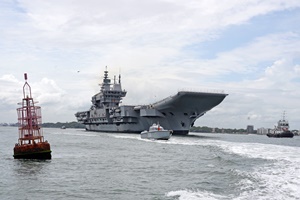Indigenous Aircraft Carrier (IAC) ‘Vikrant’ designed by Indian Navy's Directorate of Naval Design (DND) and built at Cochin Shipyard Limited (CSL), has started initial sea trials to prove its seaworthiness and manourability.

The maiden attempt of the Indian Navy and Cochin Shipyard to indigenously design and build an aircraft carrier, Vikrant is a shining example of the nation’s quest for “Atma Nirbhar Bharat” with more than 76 per cent indigenous content.
The Indigenous aircraft carrier is 262 metres long, 62 metres at the widest part and has a height of 59 metres, including the superstructure. There are 14 decks in all, including five in the superstructure. The ship has over 2,300 compartments, designed for a crew of around 1,700, including specialised cabins to accommodate women officers.
The ship has been designed with a very high degree of automation for machinery operation, ship navigation and survivability, ‘Vikrant’ has a top speed of around 28 knots and cruising speed of 18 knots with an endurance of about 7,500 nautical miles. The ship can accommodate an assortment of fixed wing and rotary aircraft.
Most of the ship construction activities have been completed and the ship has entered the trials phase. Readiness of ship’s Propulsion and Power Generation equipment/ systems was tested in harbour as part of Basin Trials in November last year.
Progress of construction of the carrier was reviewed by Hon’ble Raksha Mantri during his visit to the ship on 25 Jun 21. Though the commencement of Sea Trials was delayed due to the 2nd wave of COVID, with concentrated and dedicated efforts of large number of workmen, OEMs, engineers, overseers, inspectors, designers and the ship’s crew, who had put their heart and soul towards the ship’s readiness for sea trials. This is a major milestone activity and historical event, especially since this has been achieved in the face of the challenges posed by the current pandemic.
During the maiden sailing, ship’s performance, including hull, main propulsion, PGD and auxiliary equipment would be closely watched.
With the delivery of IAC, India would join a select group of nations with the capability to indigenously design and build aircraft carriers, which will be a real testimony to the ‘Make in India’ thrust of the government.
The Indigenous construction of the aircraft carrier has bolstered indignous design and construction capabilities besides development of large number of ancillary industries, with employment opportunities for 2,000 CSL personnel and about 12,000 employees in ancillary industries. Over 76 per cent indigenous content towards procurement of equipment, besides work by CSL and their subcontractors is being directly invested back into the Indian economy. Around 550 Indian firms, including about 100 MSMEs are registered with CSL, who are providing various services for construction of the IAC.
Indian Navy’s ship building programme is rightly poised to provide requisite ‘Economic Stimulus’, with 44 ships and submarines on order being built indigenously.
On Friday, the construction of the first warship of the Anti-Submarine Warfare Shallow Water Craft (ASWSWC) project and that of the third warship of Survey Vessel Large (SVL) project for the Indian Navy were also kickstated simultaneously at the Garden Reach Shipbuilders and Engineers (GRSE), Kolkatta.
The ships are being built by GRSE as part of the indigenous shipbuilding programme for construction of eight ASWSWC and four SVL for the Indian Navy. The ships are partly being built under a unique Public Private Partnership model by GRSE at L&T Shipyard, Kattupalli. The Keel Laying is a major milestone activity in the shipbuilding process and indicates the amalgamation of various blocks towards construction of a ship.
The construction of these vessels is a major boost for `AtmaNirbhar Bharat- mission and India’s ‘Make in India’ commitment with most of the weapons, sensors and equipment being indigenous.
The ASW Shallow Water Craft, which will be equipped with state-of-the-art underwater sensors and weapons will boost the Navy’s ASW capability. The SVL ships, capable of full-scale coastal survey, deep-water Hydrographic survey and determination of Navigational channels/ routes will also be fitted with state of art equipment.
Highlighting various challenges faced by the Shipyard in executing this complex shipbuilding project CMD-GRSE stated that despite challenges posed by the ongoing pandemic, production of the ships continued by utilisation of innovative solutions. He thanked the Indian Navy for their unstinted support and reiterated GRSE’s commitment to cater to the requirement of modern surface fleets.























